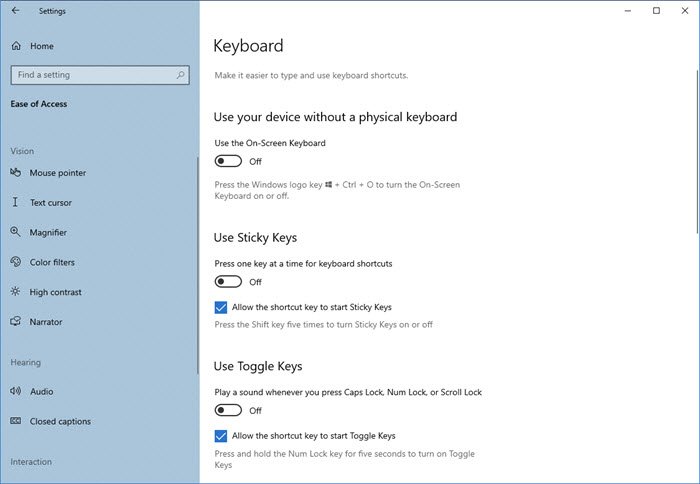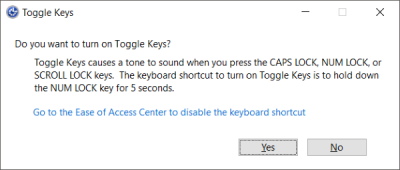Windows 11/10 has many features that help you stay productive at work. And one of them is the Ease of Access Center. The Ease of Access Settings lets you customize a few basic settings on your computer and personalize them. In this post, we’ve covered some Keyboard settings that fall under Ease of Access.
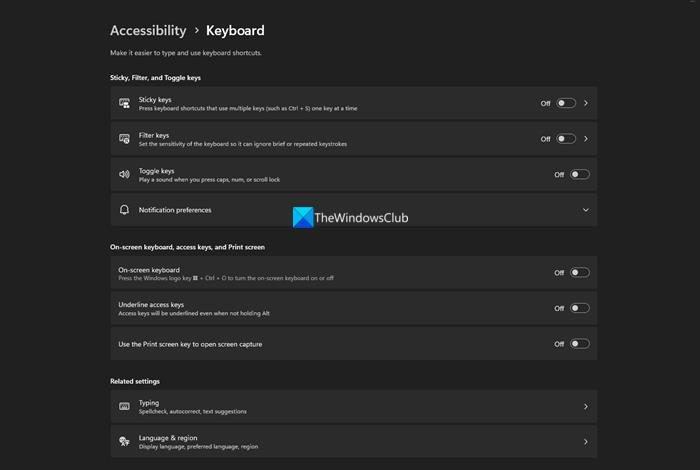
Ease of Access Keyboard Settings on Windows 11/10
Here are all the settings that are currently available:
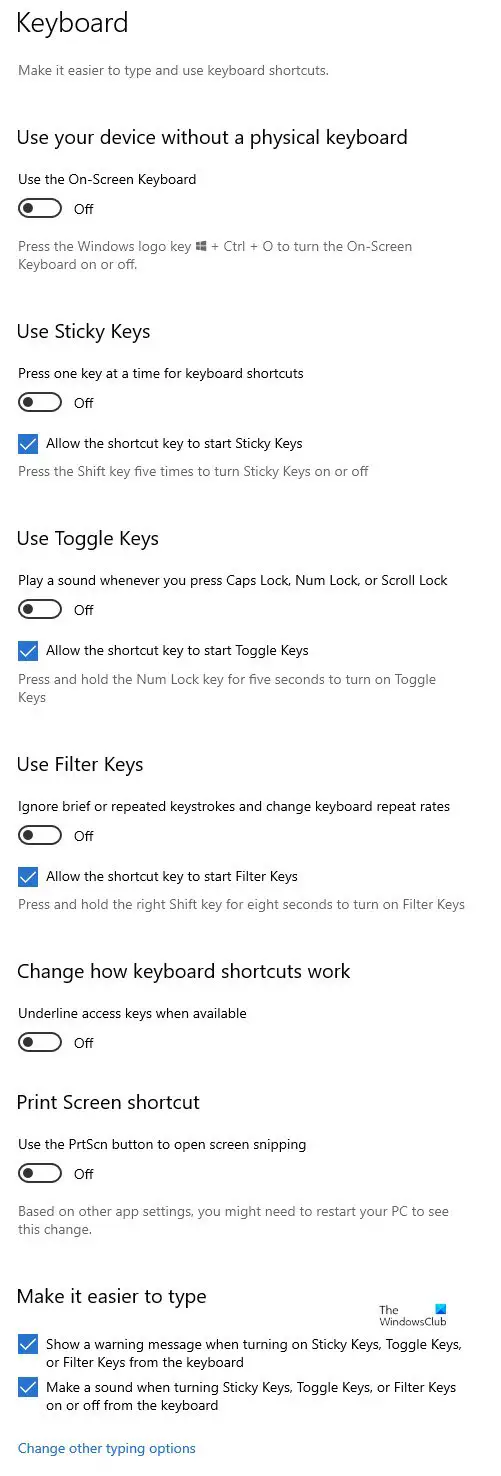
Let us take a look at them.
On Windows 11, to use the On-screen keyboard, open the Settings app, click on Accessibility, and select the Keyboard tab under the Interaction section.
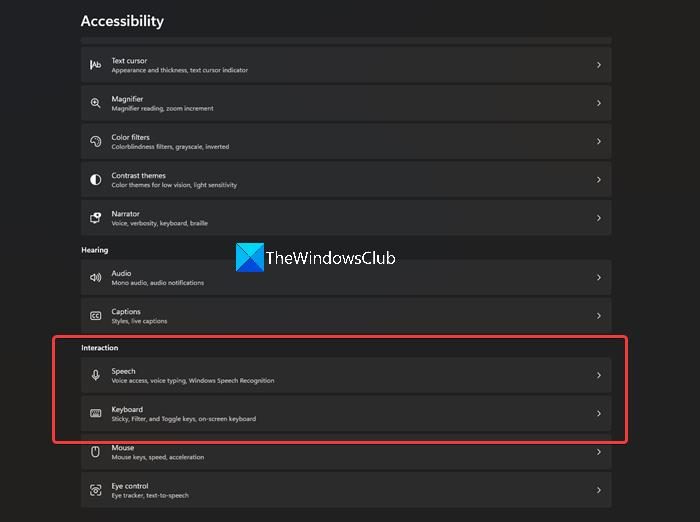
The new keyboard settings make it easier to type and use keyboard shortcuts. Simply select the Start button, choose ‘Settings’, and go to Ease of Access > Keyboard. Then, look at some of these options and configure them, as desired.
- On-screen keyboard
- Toggle for Sticky Keys
- Toggle for Toggle keys
- Toggle for Filter keys
- Toggle for Prt Scr
Ease of Access, as the name suggests, aims to make your computer and its settings more usable and provide some selective features that improve your overall experience on Windows.
On-screen keyboard
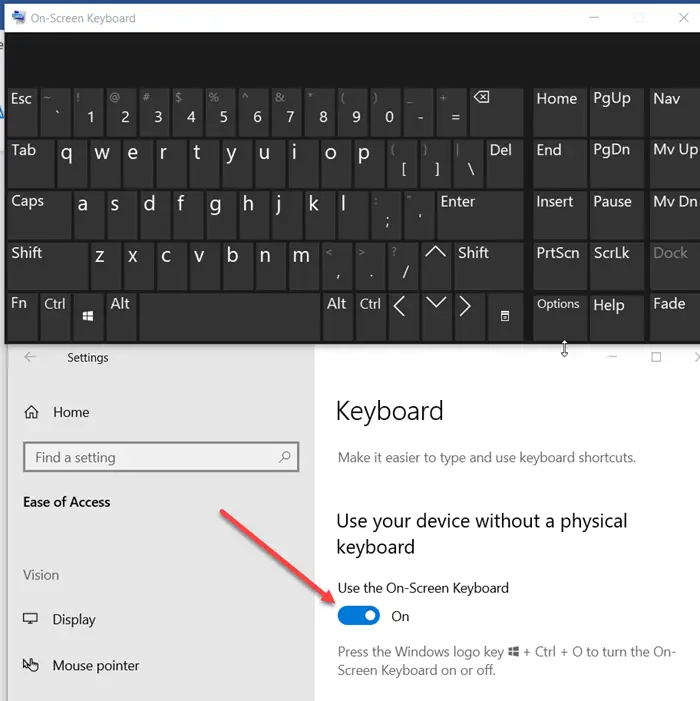
The very first change that is readily noticeable when you switch to keyboard settings under Ease of Access is the visibility of a new On-screen keyboard. Enable this option to select keys by using the mouse or another pointing device (like a joystick). Also, you can use a single switch to cycle through the keys on the screen. You can use the keyboard shortcut Win+Ctrl+O to turn the on-screen keyboard ‘On’ or ‘Off’ in an instant.
Toggle for Sticky Keys
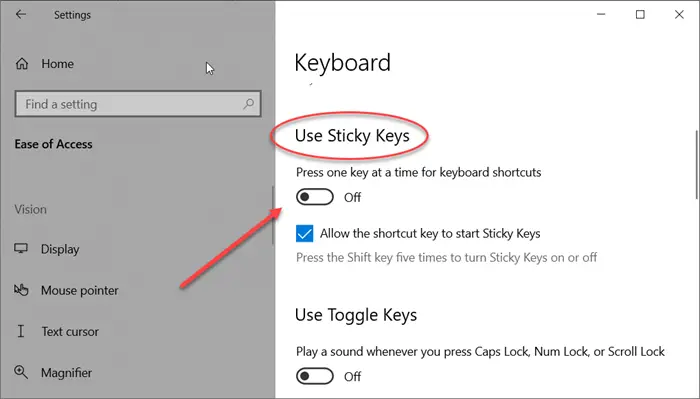
Sticky Keys helps in serializing the keystrokes instead of requiring users to press multiple keys at the same time. So, when you enable this feature, it will allow you to issue keyboard commands by pressing the buttons one after another, instead of pressing them all at the same time.
Toggle for Toggle keys
Toggle Keys enable you to play a sound whenever you press the Caps lock, Num lock, or Scroll lock keys. To activate this feature, simply switch the toggle to ‘On’ position or press and hold the Num Lock key for 5 seconds to enable or disable the feature.
Toggle for Filter keys
Filter Keys can ignore brief or repeated keystrokes and configure the sensitivity of the keyboard. To enable it, simply use the toggle switch or press and hold the Shift key for 8 seconds.
Toggle for Prt Scr
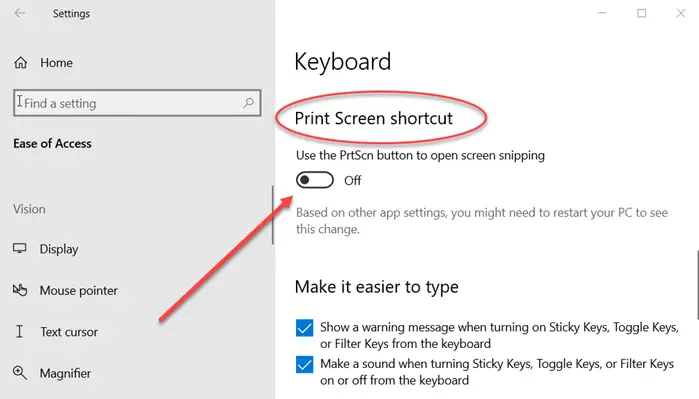
Gain easy and quick access to the Print Screen shortcut and open screen snipping by enabling this feature. Based on other app settings, you might need to restart your PC to see this change.
Shortcut Underlines
Do you like to work primarily on your keyboard? Switching between mouse and keyboard, again and again, becomes cumbersome at some stage. And then enters the keyboard shortcuts to make everything simpler. But it is not quite possible to remember all the keyboard shortcuts for all the applications.
Shortcut Underlines make it even simpler to access keyboard shortcuts without remembering them. What it does is, in the menu bar it underlines the letter of the word that corresponds to a keyboard shortcut.
For example, if you’ve enabled this setting and you go to Notepad, you will see ‘F’ of ‘File’ will be underlined. This means you can press ‘Alt + F’ on your keyboard to open the file menu. Similarly, you can open the help menu by ‘Alt + H’. This feature is quite handy and applicable to all the applications that have a menu bar and supports keyboard shortcuts.
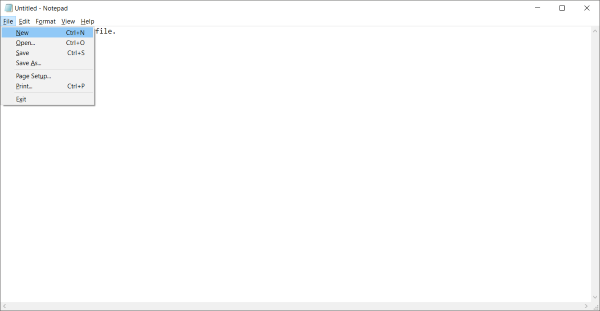
To enable shortcut underlines, go to ‘Settings’ and then select ‘Ease of Access’. Select ‘Keyboard’ from the left menu and scroll down to find ‘Enable Shortcut Underlines’ under ‘Other Settings’.
Display warning messages while changing settings with keyboard shortcuts
While you start using keyboard shortcuts extensively, it will happen that you might hit a keyboard shortcut that is assigned to change some system setting. The setting will be changed without your knowledge about it. So, to tackle this situation, there is another setting in the Ease Of Access section, and that is called ‘Display a warning message when turning a setting on or off with a shortcut’.
Enable this setting if you want to be warned about the actions of your keyboard shortcuts. You can try this feature by pressing Num Lock for 5 seconds, and you will see a warning message about the ‘Toggle Key’ settings.
There is an additional setting available along with this one, and that is ‘Make a sound when turning a setting on or off with a shortcut’. This setting will enable sound prompts if you changed a setting with the keyboard shortcut.
Both these settings are somewhat similar and are available under ‘Other Settings’ in the ‘Keyboard’ section of ‘Ease of Access’.
So, these were some of the Ease of Access Keyboard settings. Ease of Access aims to make your computer more usable for you and provide some selective features that can enhance your overall experience on Windows. You can explore Ease of Access for more such settings that you might find interesting to customize as per your requirements.
Also read: Ease of Access keyboard shortcuts
Where is the Ease of Access settings in Windows 11?
The Ease of Access settings are available in the Accessibility settings in the Settings app of Windows 11. When you open the Settings app on Windows 11, you will find the Accessibility tab on the left side of the app among many other tabs. Click on it to get to the Ease of Access settings, including the On-screen keyboard.
How do I get the Ease of Access keyboard on Windows 11?
On Windows 11, to get to the Ease of Access keyboard or the On-screen keyboard settings, open the Settings app, click on the Accessibility tab, and select the Keyboard tab under the Interaction section. You will find many options to customize how you use your keyboard as well as the On-screen keyboard options on Windows 11.
Related read: On-Screen Keyboard Settings, Tips and Tricks in Windows.
